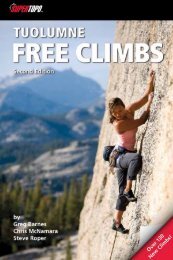The Definitive Guide To Yosemite Big Wall Climbing - SuperTopo
The Definitive Guide To Yosemite Big Wall Climbing - SuperTopo
The Definitive Guide To Yosemite Big Wall Climbing - SuperTopo
Create successful ePaper yourself
Turn your PDF publications into a flip-book with our unique Google optimized e-Paper software.
Rockfalls<br />
<strong>The</strong> passage of large glaciers scoured a lot of<br />
loose rock from the Valley walls, yet every climb<br />
listed in this book requires an approach up<br />
a talus slope, the boulder piles that flank the<br />
cliffs. <strong>The</strong> next time you hike up a talus slope,<br />
stop and think about what this voluminous<br />
deposit represents: 15,000 years worth of<br />
rockfalls from the cliff above. Although there is<br />
some local variation (surprisingly, El Capitan<br />
has more talus per contributing cliff area than<br />
Glacier Point, despite the latter's recent<br />
activity), the unavoidable conclusion from<br />
the talus is that every cliff has experienced<br />
substantial rockfall in the past. Recent<br />
documentation demonstrates that rockfalls are<br />
also common today, with a rockfall occurring<br />
somewhere in <strong>Yosemite</strong> Valley every week on<br />
average.<br />
Climbers have generally managed<br />
to avoid naturally occurring rockfalls,<br />
with a few tragic exceptions. However,<br />
the number of climbers on <strong>Yosemite</strong>'s<br />
walls grows each year, increasing the<br />
likelihood of an incident. Scientists<br />
actively study <strong>Yosemite</strong> rockfalls<br />
but reliable prediction is unlikely<br />
to happen anytime soon. Climbers<br />
must take personal responsibility for<br />
addressing rockfall risk. How to do that?<br />
Unfortunately there are no hard or fast<br />
rules, but here are a few things to keep<br />
in mind: Rockfall detachment areas are<br />
often active over many weeks or months,<br />
so avoid climbing beneath these areas.<br />
Fresh talus and/or broken vegetation<br />
at the base of your intended climb are<br />
good indicators of recent activity. Be<br />
especially aware of cracking or popping<br />
sounds emanating from the cliffs, as<br />
these sounds have preceded many<br />
rockfalls. A helmet may not save you<br />
from a large rockfall, but it could offer<br />
protection from “flyrock,” rock shrapnel<br />
that accompanies most rockfalls. Above<br />
all, use your common sense and trust<br />
your instincts; if that inner voice is<br />
telling you that the situation is not safe,<br />
it probably isn’t.<br />
FOR CURRENT ROUTE INFORMATION, VISIT SUPERTOPO.COM<br />
INTRODUCTION<br />
Rockfalls have shaped <strong>Yosemite</strong>’s big<br />
walls (the Great Roof is but one of many<br />
iconic features that owe their existence to<br />
rockfalls) but they also pose potential hazards.<br />
A Super<strong>To</strong>po post once compared the<br />
relationship between climbing and rockfalls to<br />
that between surfing and shark attacks. Like<br />
shark attacks, the probability of experiencing<br />
a rockfall while climbing is remote, but it is<br />
always possible. Most climbers agree that some<br />
risk is worth accepting in order to travel across<br />
the incredible granites – and through 100<br />
million years of Earth's history – that comprise<br />
<strong>Yosemite</strong>'s big walls.<br />
Rockfall on Half Dome on July 27, 2006.<br />
Photo Amanda Nolan<br />
17
















